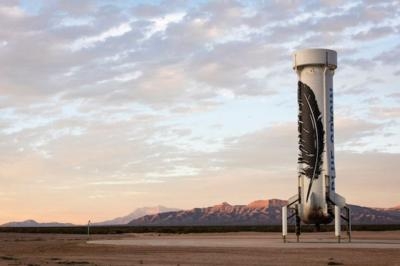Wed, Nov 25, 2015
Only Time Will Tell If The Booster Is Truly Reusable
News/Analysis By Wes Oleszewski
On November 23, 2015 Blue Origin achieved a first in rocketry and spaceflight history when their New Shepard launch vehicle successfully delivered a payload across the official boundary of space and then returned to Earth to land upright under rocket power.

Working in near secrecy and well out of sight of the media Blue Origin has netted engineering results that gave the company the opportunity to reach this unique milestone. While landing a large rocket powered vehicle upright had been done in the past both with the McDonnell Douglas DC-X in the 1990s and with SpaceX’s Grasshopper more recently, neither vehicle was designed to reach space with a payload. SpaceX has tried twice to land the first stage of its Falcon 9 launch vehicle and failed each time. Blue Origin also failed in its first attempt to land the New Shepard booster on April 29, 2015. Yet the bugs seem to be fully worked out of their system this time.
New Shepard landed just 4.5 feet from the dead center of the target at a touchdown speed of just 4.4 miles per hour. This after boosting the vehicle’s spacecraft in a high altitude toss to an altitude of 329,839 feet, or 100.5 Km which is just beyond the internationally recognized boundary of “space.” The flight was launched from Blue Origin’s secluded West Texas launch site shortly after the hour of noon Eastern time.
In spite of scores of SpaceX fans who have scoffed at Blue Origin’s ability to achieve the historic milestone that their favored space company has failed to meet, the fact is that this is a spaceflight first. At this moment Blue Origin has in their possession a flight ready booster that has been flown and can now be flown again. That task was accomplished without a legion of internet fans, without a huge influx of NASA funds and without a doughnut wall.

Yet the questions now remain, how re-useable will be this re-usability? Will the New Shepard vehicles be able to safely and reliably fly passengers beyond the space boundary over and over to the point where the company can actually earn money? Or, will the system suffer the same myth of re-usability that the Space Shuttle experienced? Granted, the sub-orbital system is far less complex in countless ways including fuels and operational environment, but there are always factors that sap the bottom line in any flying venture.
For now, however, the team at Blue Origin has made spaceflight history and no one can ever take that away from them. I only wish that they would have let us all watch it live rather than telling us afterward in Soviet-like space tradition.
(Images provided by Blue Origin)
More News
Aviation Governance Secured...At Least For a While The National Business Aviation Association similarly applauded the passage of the FAA's recent reauthorization, contentedly recou>[...]
Emphasis On Growing The Future of Aviation Through Concentration on 'AFFORDABLE FLYERS' It's been a number of years since the Latest Edition of Jim Campbell's HUGE SportPlane Resou>[...]
Amazilia Aerospace GmbH, Develops Digital Flight Control, Flight Guidance And Vehicle Management Systems Textron eAviation has acquired substantially all the assets of Amazilia Aer>[...]
Honeywell's Primus Brings New Tools and Niceties for Hawker Operators Hawker 4000 business jet operators have a new installation on the table, now that the FAA has granted an STC f>[...]
Company Celebrates Niche-but-Important Advancement in Industry Standards Echodyne has announced full integration of its proprietary 'EchoFlight' radar into the e American Aerospace>[...]
 Bolen Gives Congress a Rare Thumbs-Up
Bolen Gives Congress a Rare Thumbs-Up The SportPlane Resource Guide RETURNS!!!!
The SportPlane Resource Guide RETURNS!!!! Buying Sprees Continue: Textron eAviation Takes On Amazilia Aerospace
Buying Sprees Continue: Textron eAviation Takes On Amazilia Aerospace Hawker 4000 Bizjets Gain Nav System, Data Link STC
Hawker 4000 Bizjets Gain Nav System, Data Link STC Echodyne Gets BVLOS Waiver for AiRanger Aircraft
Echodyne Gets BVLOS Waiver for AiRanger Aircraft




